Technical Analysis Price Patterns
Chart patterns are part of buying and selling rules. Most of the time there will already be an open position at the appearance of a price chart pattern. The point is that it gives an important confirmation for the already taken decision. Furthermore, some patterns will help to calculate future price targets.
Medium- and long-term trend reversals are often gradual. The art is to distinguish that you are dealing with a continuation pattern, after which the price will continue its previous trend or a reversal pattern leading to a trend reversal.
Medium- and long-term trend reversals are often gradual. The art is to distinguish that you are dealing with a continuation pattern, after which the price will continue its previous trend or a reversal pattern leading to a trend reversal.
Reversal Patterns
Head and Shoulders Formation
The head and shoulders formation belongs with an accuracy of about 90% to the most reliable reversal patterns
Head and Shoulders Top Reversal Pattern
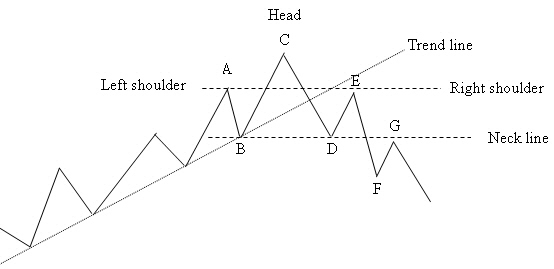
Figure 4.39: Head and shoulders top reversal principle.
The price moves in an uptrend. Only after the pattern has formed, you will recognize A as the left shoulder (figure 4.39). The price drops back to the support B of the up-going trendline. From here, the price makes a last move up to C often with lower volume compared to the A move. This will be the head of the pattern. The turning point at B will be part of the neck line.
Next the price drops through the up-going trendline and falls back to the level of the neck line D. After that, the price will move up again to E to form the right shoulder. From here the price will drop below the neck line making lower lows.
The shoulders (A-E) and the neck line (B-D) in the head and shoulders formation should be at about the same price level and at about the same distance in time from the head.
The head and shoulders pattern is confirmed when the price falls below an up-trending neck line or after the right shoulder in case of a down-trending neck line.
The head and shoulders pattern is confirmed when the price falls below an up-trending neck line or after the right shoulder in case of a down-trending neck line.
ATTENTION! In approximately half of the cases, there is a bounce back up to the neck line G, or even up to between the neck line and the right shoulder.
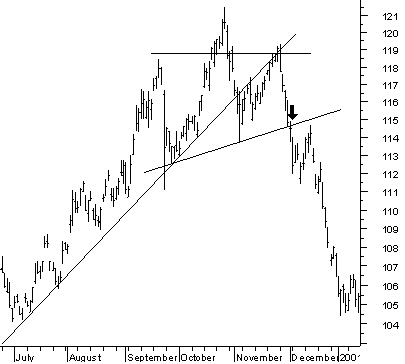

Figure 4.40: Head and shoulders top reversal pattern.
Figure 4.40 shows an example of a head and shoulders top reversal pattern in the Euro-dollar currency pair.
Figure 4.40 shows an example of a head and shoulders top reversal pattern in the Euro-dollar currency pair.
Head and Shoulders Bottom Reversal Pattern
Mirroring the head and shoulders top reversal pattern gives a head and shoulders bottom reversal pattern. Shoulder bottoms should be at around the same price level and at about the same distance from the head.
The head and shoulders bottom reversal pattern is confirmed when the price moves above a descending neck line or after the right shoulder with an ascending neck line.
ATTENTION! In approximately half of the cases, there is a bounce back down to the neck line or even down to between the neck line and the right shoulder.
Look at figure 4.41 for an example of a head and shoulders bottom reversal.
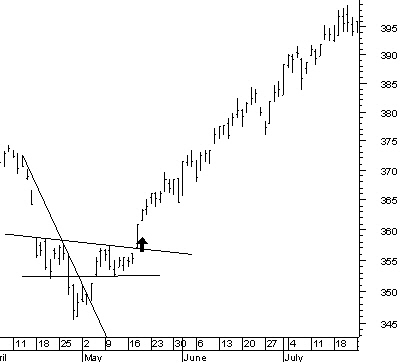
Figure 4.41: Head and shoulders bottom reversal pattern.
Technical Analysis Price Patterns
Reversal Patterns
Double Tops and Bottoms
Double Top
A double top reversal pattern is formed with a large demand during the formation of the first top and a lack of demand with the second top.

With daily price bars (figure 4.46), tops are separated by about four to eight weeks and should only have a small difference in price level. The in between reaction should have a price drop of about 10% measured from the first top.
With an accuracy of 80%, this pattern is very reliable.
The pattern is confirmed when the price falls below the level of the middle reaction.
Figure 4.46: Double top pattern.
Double Bottom
 For a double bottom, the reasoning is analogous to that of a double top. The trend is down, and a double bottom pattern is formed as an indication that the trend probably will reverse.
For a double bottom, the reasoning is analogous to that of a double top. The trend is down, and a double bottom pattern is formed as an indication that the trend probably will reverse.
With daily price bars, bottoms are separated by about four to eight weeks (figure 4.47) and should only have a small difference in price level. The in between reaction should have a price rise of about 10% measured from the first bottom.
With 80% reversals, this pattern is very reliable.
The pattern is confirmed when the price rises above the level of the middle reaction.
The pattern is confirmed when the price rises above the level of the middle reaction.
Figure 4.47: Double bottom pattern
Rounding Bottoms
A rounding bottom pattern (rounded bowl shape) appears on daily and weekly bar charts.
This pattern takes time to complete.
The price can peak halfway through the pattern, but usually it retraces most of it quickly.
Rounding bottoms are becoming rare because of the high volatility of the markets as a result of the information society.
Rounding bottoms lead to a price reversal 90% of the time.
This pattern takes time to complete.
The price can peak halfway through the pattern, but usually it retraces most of it quickly.
Rounding bottoms are becoming rare because of the high volatility of the markets as a result of the information society.
Rounding bottoms lead to a price reversal 90% of the time.

Figure 4.48: Rounding bottom pattern.
Like in figure 4.48, a rounding bottom starts with a steep falling trendline that with time, becomes increasingly flat.
The opposite is true in most of the other patterns; that is, you start with a flat trendline and finish with a steeper trendline.
The pattern confirms when the price closes above the highest peak of the pattern. There may be a saucer lip when the price drops temporarily before continuing the uptrend.
>V-formations
In a V-formation, you are looking for a V-shaped reversal pattern from a range of bars. A bottom reversal creates a V-character; a top reversal creates an inverted V-character.
The price at the start of the V-formation will form either a one-day reversal, an island reversal, or a spark.
The price at the start of the V-formation will form either a one-day reversal, an island reversal, or a spark.

Figure 4.49: V-formation; one day top reversal.
A one day top reversal (figure 4.49) arises if the price makes a new high on the same day and reverses and closes below the closing price of the previous day. A one-day top reversal in a candle chart is a black candle and often is part of a candlestick pattern.

Figure 4.50: V-formation; one day bottom reversal.
A one-day bottom reversal (figure 4.50) arises if the price makes a new low on the same day and reverses and closes above the closing price of the previous day.
An island reversal occurs when there is a window between the prices of today, the previous day, and the following day(s).
A spark is a big, one-day high volatility price move. A V-formation start can be recognized most of the time when it breaks the last possible steep trendline, together with a candle stick reversal pattern just before, and a one-day island or spark reversal.
Technical Analysis Price Patterns
Continuation Patterns
After a continuation pattern, the price continues the previous trend. Continuation patterns are a very good indication for entering a trade after a trend reaction.
Triangles
Triangle formations appear as symmetrical triangles, ascending triangles, and descending triangles. The triangle is a correction pattern for the previous price move. A triangle formation takes a minimum of 30 bars. Shorter-period triangle formations are classified as pennants.
Triangles in an Uptrend

Figure 4.51: Symmetrical triangle pattern.
In the weekly price chart in figure 4.51, you can see higher bottoms and lower tops; this creates a symmetrical triangle. A breakout in the direction of the previous trend confirms the continuation pattern.

In the weekly price chart in figure 4.51, you can see higher bottoms and lower tops; this creates a symmetrical triangle. A breakout in the direction of the previous trend confirms the continuation pattern.

Figure 4.52: Descending triangle pattern.
In the daily chart in figure 4.52, lower tops are made in an uptrend. Next, the price drops back to horizontal support levels, and a descending triangle is created. A breakout in the direction of the previous trend confirms the continuation pattern.
In the daily chart in figure 4.52, lower tops are made in an uptrend. Next, the price drops back to horizontal support levels, and a descending triangle is created. A breakout in the direction of the previous trend confirms the continuation pattern.
The Rectangle
The rectangle is a relatively rare pattern, appearing almost always as a continuation pattern, although it can exist as a reversal pattern. The price moves between two horizontal trendlines and touches a minimum of two times each line.
Rectangle in an Uptrend
Figure 4.54 shows a rectangle continuation pattern in an uptrend.

Figure 4.54: Rectangle continuation pattern in an uptrend.
Rectangle in a down trend
Figure 4.55 shows a rectangle continuation pattern in a downtrend.

Figure 4.55: Rectangle continuation pattern in a downtrend.
Flags and Pennants
With a continuation of the previous trend 90% of the time, flags and pennants are reliable short term continuation patterns. They create a pause from 5 up to 25 bars in the current trend and then continue the previous trend. Most of the flags and pennants take up from 10 to 15 bars. Generally, the volume goes down during this phase.
Flags in an Uptrend
Figure 4.56 shows flags in an uptrend.


Figure 4.56: Flags in an uptrend.
Pennants in a Downtrend
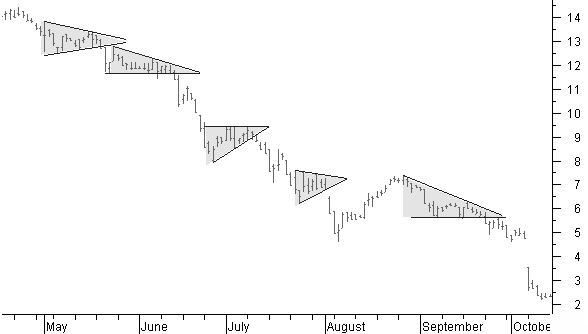
Figure 4.59: Pennants in a downtrend.
Look at pennants in a downtrend in figure 4.59.
Technical Analysis Price Patterns
Reversing/Continuation Patterns
Some of the patterns we consider can appear as a reversal or as a continuation pattern.
Rounding Top as a Reversing Pattern
A rounding top pattern (inverse rounded bowl shape) appears on daily and weekly bar charts.
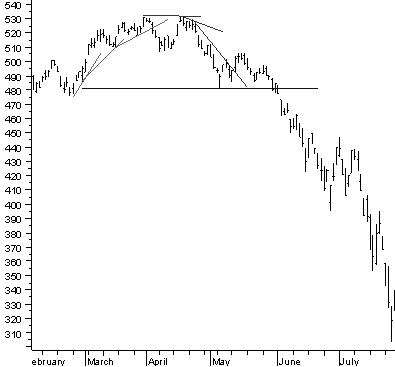
Figure 4.60: Rounding top reversal pattern.
A rounding top starts with a steep rising trendline (figure 4.60) which with time becomes increasingly flat. Rounding tops as a reversing pattern break to the down side and lead to a farther move down 90% of the time. The pattern confirms when the price closes below the left-hand border or with a saucer lip when breaking the right-hand side of the border.
Rounding Top as a Continuation Pattern
A break to the upper side of the saucer gives, on average, less profit than a break to the lower side. This is simply because, as a continuation pattern, part of the up-move already has been completed.

Figure 4.61: Rounding top continuation pattern.
A rounding top as a continuation pattern is confirmed when the price moves above the highest point of the rounding top (figure 4.61).
Diamond Formation
The diamond formation is a combination of two triangles. The left is an inverted broadening triangle; the right side is a symmetrical triangle. Together they make up a diamond formation.
This pattern is most common as a continuation pattern, but it can be a top or bottom reversal pattern as well.
Diamond Formation as a Continuation Pattern

Figure 4.62 shows a diamond continuation pattern.
Diamond Formation as a Reversal Pattern
Top Reversal
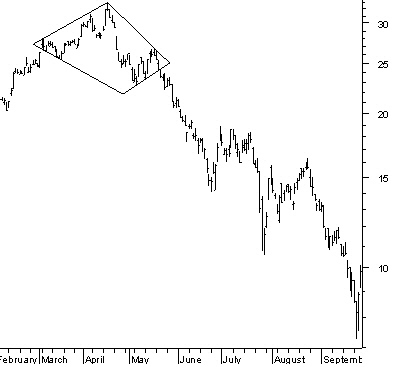
Figure 4.63 shows a diamond top reversal pattern.
Technical Analysis Price Patterns
Wedge Formations
 Wedge formations in are not only interesting as reversal or continuation patterns but are also good for recognizing an Elliott beginning or ending wedge impulse wave. So they will help to make a correct Elliott wave count in generally difficult circumstances.
Wedge formations in are not only interesting as reversal or continuation patterns but are also good for recognizing an Elliott beginning or ending wedge impulse wave. So they will help to make a correct Elliott wave count in generally difficult circumstances. Falling Wedge Reversal Pattern
The falling wedge exists as a reversing pattern in a falling trend and as a continuation pattern in a rising trend. The duration of the wedge should be a minimum of 20 bars; with fewer than 20 bars, it is considered a flag.
Figure 4.65: Falling wedge reversal pattern.
Breaking out of a falling wedge is generally a bullish signal (figure 4.65). Rarely will you see the price breaking a falling wedge to the lower side.
Falling Wedge Continuation Pattern

A falling wedge continuation pattern in a rising trend is a price reaction in the up-going move.
The chance for a big profit is less than for a falling wedge reversal pattern because part of the up-move is already history (figure 4.66).
Figure 4.66: Falling wedge continuation pattern.
Pay attention to the rare falling wedge after the top of an up-trend.
 In figure 4.67, the falling wedge from the top probably is the first reaction after a longer-term uptrend.
In figure 4.67, the falling wedge from the top probably is the first reaction after a longer-term uptrend.
As a result the breakout to the upper side is more likely a temporary reaction against the new longer-term down-move.
Figure 4.67: Falling wedge after a top formation.
Technical Analysis Price Patterns
Wedge Formations (Continued)
Rising Wedge Reversal Pattern
The rising wedge exists as a reversal pattern in a rising trend and as a continuation pattern in a falling trend.
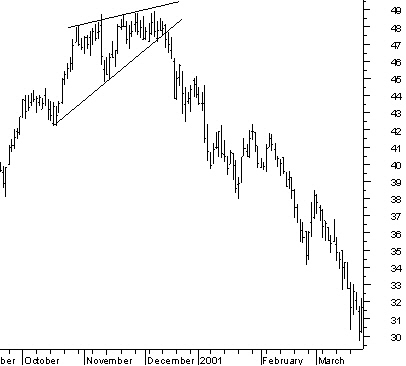
The duration of the wedge should be a minimum of 20 bars; with fewer than 20 bars, it is considered a pennant.
Breaking out of a rising wedge is generally a bearish signal (figure 4.68).
It is rare for the price to break to the upper side of the rising wedge, although it can happen.
Figure 4.68: Rising wedge reversal pattern.
Rising Wedge Continuation Pattern
A rising wedge continuation pattern in a falling trend is a price reaction to the down-move.

The chance for a big profit is less for a rising wedge continuation pattern than for a rising wedge reversal pattern because part of the down-move is already history (figure 4.69).
Figure 4.69: Rising wedge continuation pattern.
Pay attention to the rare rising wedge after the bottom of a downtrend, as in figure 4.70.

Figure 4.70: Rising wedge after a bottom formation.
Here the rising wedge probably is the first reaction after a longer-term downtrend. The breakout to the lower side is most likely a temporary reaction against the new longer-term up-move.